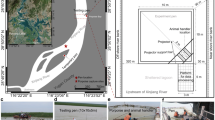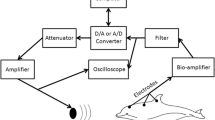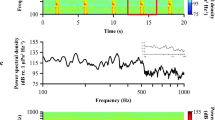Abstract
The hearing sensitivity of the lined seahorse, Hippocampus erectus (Perry), was determined for both sound pressure and particle acceleration using the auditory evoked potential (AEP) technique. Hippocampus erectus demonstrates hearing sensitivity typical of historically characterized hearing generalist fishes, with best sensitivities below 600 Hz and maximum sensitivities of 105.0 ± 1.5 dB SPL (re: 1 μPa) and 3.46 × 10−3 ± 7.64 × 10−4 m s−2 at 200 Hz. The shapes of the audiograms for each modality are similar, suggesting relative similarity in sensitivity between modalities for a given frequency. In light of the importance of broadband sound in the acoustic landscape of this fish’s environment, and broadband conspecific sound production that may be used in intraspecific acoustic communication, audition to broadband sounds was also estimated. Maximum broadband sensitivity at 200 Hz is estimated to be 92.0 ± 1.5 dB SPL (re: 1 μPa) and 7.73 × 10−4 ± 1.71 × 10−4 m s−2.




Similar content being viewed by others
References
Bass AH, Clark CW (2003) The physical acoustics of underwater sound communication. In: Simmons AM, Popper AN, Fay RR (eds) Acoustic communication. Springer, New York, pp 15–64
Cahn PH, Siler W, Wodinsky J (1969) Acoustico-lateralis system of fishes: tests of pressure and particle-velocity sensitivity in grunts, Haemulon sciurus and Haemulon parrai. J Acoust Soc Am 46(6):1572–1578
Casper BM, Mann DA (2006) Evoked potential audiograms of the nurse shark (Ginglystoma cirratum) and the yellow stingray (Urobatis jamaicensis). Env Biol Fish 76:101–108
Chapman CJ, Johnstone ADF (1974) Some auditory discrimination experiments on marine fish. J Exp Biol 61:521–528
Colson DJ, Patek SN, Brainerd EL, Lewis SM (1998) Sound production during feeding in Hippocampus seahorses (Syngnathidae). Env Biol Fish 51:221–229
Corwin JT, Bullock TH, Schweitzer J (1982) The auditory brain stem response in five vertebrate classes. Electroen Clin Neuro 54:629–641
Davis H (1976) Principles of electric response audiometry. Ann Otol Rhinol Laryngol 85(Suppl 29):1–95
Dusenbery DB (1992) Sensory ecology: how organisms acquire and respond to information. Freeman, New York
Egner SA, Mann DA (2005) Auditory sensitivity of sergeant major damselfish Abudefduf saxatilis from post-settlement juvenile to adult. Mar Ecol Prog Ser 285:213–222
Fay RR, Hillery CM, Bolan K (1982) Representation of sound pressure and particle motion information in the midbrain of the goldfish. Comp Biochem Physiol A 71:181–191
Fay RR, Popper AN (1975) Modes of stimulation of the teleost ear. J Exp Biol 62:379–387
Fish MP (1953) The production of underwater sound by the northern seahorse, Hippocampus hudsonius. Copeia 1953(2):98–99
Hawkins AD, Johnstone ADF (1978) The hearing of the Atlantic salmon, Salmo salar. J Fish Biol 13:655–673
Horodysky AZ, Brill RW, Fine ML, Musick JA, Latour RJ (2008) Acoustic pressure and particle motion thresholds in six sciaenid fishes. J Exp Biol 211:1504–1511
Jacobson JT (1985) An overview of the auditory brainstem response. In: Jacobson JT (ed) The auditory brainstem response. College-Hill, San Diego, pp 3–12
Jerkø H, Turunen-Rise I, Enger PS, Sand O (1989) Hearing in the eel (Anguilla anguilla). J Comp Physiol A 165:455–459
Kelly JC, Nelson DR (1975) Hearing thresholds of the horn shark, Heterodotus francisci. J Acoust Soc Am 58(4):905–909
Kenyon TN, Ladich F, Yan HY (1998) A comparative study of hearing ability in fishes: the auditory brainstem response approach. J Comp Physiol A 182:307–318
Lovell JM, Findlay MM, Moate RM, Nedwell JR, Pegg MA (2005) The inner ear morphology and hearing abilities of the Paddlefish (Polyodon spathula) and the Lake Sturgeon (Acipenser fulvescens). Comp Biochem Physiol A 142:286–296
Lugli M, Yan HY, Fine ML (2003) Acoustic communication in two freshwater gobies: the relationship between ambient noise, hearing thresholds, and sound spectrum. J Comp Physiol A 189:309–320
McConnell JA (2003) Analysis of a compliantly suspended acoustic velocity sensor. J Acoust Soc Am 113:1395–1405
McConnell JA, Jensen SC (2006) Development of a miniature pressure-acceleration probe for bioacoustic applications. J Acoust Soc Am 119:3446
Medwin H, Clay CS (1998) Fundamentals of acoustical oceanography. Academic, San Diego
Picton TW, Stapells DR, Campbell KB (1981) Auditory evoked potentials from the human cochlea and brainstem. J Otolaryngol 10(Suppl 9):1–41
Popper AN, Fay RR (1993) Sound detection and processing by fish: critical review and major research questions. Brain Behav Evol 41:14–38
Popper AN, Fay RR (1999) The auditory periphery in fishes. In: Fay RR, Popper AN (eds) Comparative hearing: fish and amphibians. Springer, New York, pp 43–100
Popper AN, Fay RR (2011) Rethinking sound detection by fishes. Hear Res 273(1–2):25–36
Popper AN, Fay RR, Platt C, Sand O (2003) Sound detection mechanisms and capabilities of teleost fishes. In: Collins SP, Marshall NJ (eds) Sensory processing in aquatic environments. Springer, New York, pp 3–38
Sand O, Enger PS (1973) Evidence for an auditory function of the swimbladder in the cod. J Exp Biol 59:405–414
Scholik AR, Yan HY (2002) The effects of noise on the auditory sensitivity of the bluegill sunfish, Lepomis macrochirus. Comp Biochem Physiol A 133:43–52
Schroeder LL, Kramer SJ (1989) The very basics of ABR. The Interstate Printers and Publishers, Danville
Urick RJ (1975) Principles of underwater sound. McGraw-Hill, New York
Vincent ACJ (1994) Seahorses exhibit conventional sex roles in mating competition, despite male pregnancy. Behaviour 128:135–151
Vincent ACJ, Sadler LM (1995) Faithful pair bonds in wild seahorses, Hippocampus whitei. Anim Behav 50:1557–1569
Wenz GM (1962) Acoustic ambient noise in the ocean: spectra and sources. J Acoust Soc Am 34(12):1936–1956
Wysocki LE, Codarin A, Ladich F, Picciulin M (2009) Sound pressure and particle acceleration audiograms in three marine fish species from the Adriatic Sea. J Acoust Soc Am 126(4):2100–2107
Yan HY (2001) A non-invasive electrophysiological study on the enhancement of hearing ability in fishes. Proc Inst Acoust UK 23(2):15–25
Yan HY, Fine ML, Horn NS, Colon WE (2000) Variability in the role of the gasbladder in fish audition. J Comp Physiol A 187:371–379
Yost WA (2000) Fundamentals of hearing. Academic, San Diego
Acknowledgments
Many thanks to B. Casper, M. Hill Cook, R. Hill, and J. Locascio (University of South Florida) for guidance with AEP methodology, A. Noxon (Acoustic Sciences Corporation), who shared soundproofing design concepts, R. Shrivastav (University of Florida) and J. Pattee (Pioneer Hill Software) for guidance with sound analysis, P. Perkins (Florida Aquarium) for illustrations provided in Figs. 1 and 2, and W.J. Lindberg, D. Murie, D. Parkyn, C. St. Mary (University of Florida), I. Berzins (Florida Aquarium), H. Masonjones (University of Tampa), and two anonymous reviewers, who provided constructive criticism for improvement of the manuscript.
Seahorses were donated by Above the Reef and R. Stevens, his crew, and the Twin Rivers Marina. Live brine shrimp was donated by Sea Critters, Inc. P. Anderson was supported by the University of Florida Alumni Fellowship, the Morris Animal Foundation, The Florida Aquarium Center for Conservation, The Spurlino Foundation, and an anonymous donor.
Animal collection was authorized by the Florida Fish and Wildlife Conservation Commission Special Activities License #05SR-944 and husbandry and experimental protocols were authorized by the University of Florida IACUC Protocol #D-432, by the University of South Florida IACUC Protocol #2118, and by the Florida Aquarium Animal Care and Use Committee.
Author information
Authors and Affiliations
Corresponding author
Rights and permissions
About this article
Cite this article
Anderson, P.A., Mann, D.A. Evoked potential audiogram of the lined seahorse, Hippocampus erectus (Perry), in terms of sound pressure and particle acceleration. Environ Biol Fish 91, 251–259 (2011). https://doi.org/10.1007/s10641-011-9772-8
Received:
Accepted:
Published:
Issue Date:
DOI: https://doi.org/10.1007/s10641-011-9772-8




